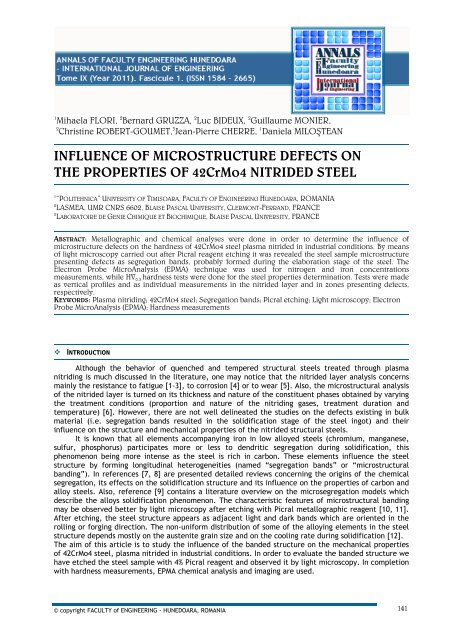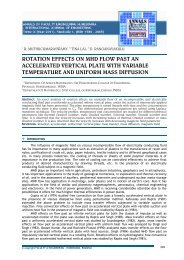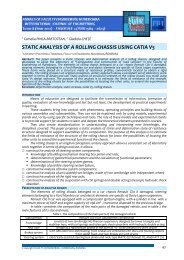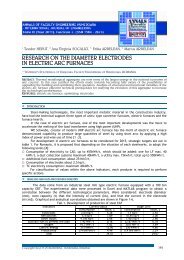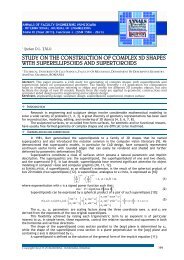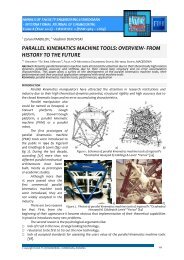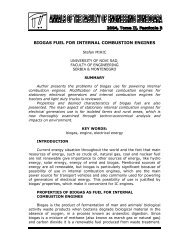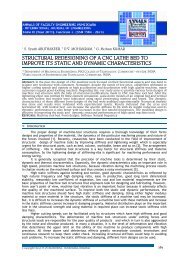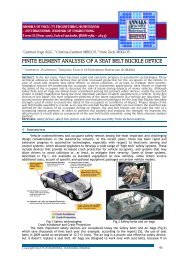INFLUENCE OF MICROSTRUCTURE DEFECTS ON THE ...
INFLUENCE OF MICROSTRUCTURE DEFECTS ON THE ...
INFLUENCE OF MICROSTRUCTURE DEFECTS ON THE ...
You also want an ePaper? Increase the reach of your titles
YUMPU automatically turns print PDFs into web optimized ePapers that Google loves.
1 Mihaela FLORI, 2 Bernard GRUZZA, 2 Luc BIDEUX, 2 Guillaume M<strong>ON</strong>IER,<br />
2 Christine ROBERT-GOUMET, 3 Jean-Pierre CHERRE, 1 Daniela MILOŞTEAN<br />
<strong>INFLUENCE</strong> <strong>OF</strong> <strong>MICROSTRUCTURE</strong> <strong>DEFECTS</strong> <strong>ON</strong><br />
<strong>THE</strong> PROPERTIES <strong>OF</strong> 42CrMo4 NITRIDED STEEL<br />
1 “POLITEHNICA” UNIVERSITY <strong>OF</strong> TIMISOARA, FACULTY <strong>OF</strong> ENGINEERING HUNEDOARA, ROMANIA<br />
2 LASMEA, UMR CNRS 6602, BLAISE PASCAL UNIVERSITY, CLERM<strong>ON</strong>T-FERRAND, FRANCE<br />
3 LABORATOIRE DE GENIE CHIMIQUE ET BIOCHIMIQUE, BLAISE PASCAL UNIVERSITY, FRANCE<br />
ABSTRACT: Metallographic and chemical analyses were done in order to determine the influence of<br />
microstructure defects on the hardness of 42CrMo4 steel plasma nitrided in industrial conditions. By means<br />
of light microscopy carried out after Picral reagent etching it was revealed the steel sample microstructure<br />
presenting defects as segregation bands, probably formed during the elaboration stage of the steel. The<br />
Electron Probe MicroAnalysis (EPMA) technique was used for nitrogen and iron concentrations<br />
measurements, while HV 0.3 hardness tests were done for the steel properties determination. Tests were made<br />
as vertical profiles and as individual measurements in the nitrided layer and in zones presenting defects,<br />
respectively.<br />
KEYWORDS: Plasma nitriding; 42CrMo4 steel; Segregation bands; Picral etching; Light microscopy; Electron<br />
Probe MicroAnalysis (EPMA); Hardness measurements<br />
INTRODUCTI<strong>ON</strong><br />
Although the behavior of quenched and tempered structural steels treated through plasma<br />
nitriding is much discussed in the literature, one may notice that the nitrided layer analysis concerns<br />
mainly the resistance to fatigue [1-3], to corrosion [4] or to wear [5]. Also, the microstructural analysis<br />
of the nitrided layer is turned on its thickness and nature of the constituent phases obtained by varying<br />
the treatment conditions (proportion and nature of the nitriding gases, treatment duration and<br />
temperature) [6]. However, there are not well delineated the studies on the defects existing in bulk<br />
material (i.e. segregation bands resulted in the solidification stage of the steel ingot) and their<br />
influence on the structure and mechanical properties of the nitrided structural steels.<br />
It is known that all elements accompanying iron in low alloyed steels (chromium, manganese,<br />
sulfur, phosphorus) participates more or less to dendritic segregation during solidification, this<br />
phenomenon being more intense as the steel is rich in carbon. These elements influence the steel<br />
structure by forming longitudinal heterogeneities (named “segregation bands” or “microstructural<br />
banding”). In references [7, 8] are presented detailed reviews concerning the origins of the chemical<br />
segregation, its effects on the solidification structure and its influence on the properties of carbon and<br />
alloy steels. Also, reference [9] contains a literature overview on the microsegregation models which<br />
describe the alloys solidification phenomenon. The characteristic features of microstructural banding<br />
may be observed better by light microscopy after etching with Picral metallographic reagent [10, 11].<br />
After etching, the steel structure appears as adjacent light and dark bands which are oriented in the<br />
rolling or forging direction. The non-uniform distribution of some of the alloying elements in the steel<br />
structure depends mostly on the austenite grain size and on the cooling rate during solidification [12].<br />
The aim of this article is to study the influence of the banded structure on the mechanical properties<br />
of 42CrMo4 steel, plasma nitrided in industrial conditions. In order to evaluate the banded structure we<br />
have etched the steel sample with 4% Picral reagent and observed it by light microscopy. In completion<br />
with hardness measurements, EPMA chemical analysis and imaging are used.<br />
© copyright FACULTY of ENGINEERING - HUNEDOARA, ROMANIA<br />
141
EXPERIMENTAL AND ANALYSIS DETAILS. SAMPLE PREPARATI<strong>ON</strong><br />
ANNALS <strong>OF</strong> FACULTY ENGINEERING HUNEDOARA – International Journal Of Engineering<br />
In this study we have used a cylindrical piece (~25 mm diameter and ~10 mm thickness) of<br />
42CrMo4 steel grade whose chemical composition (in wt%) was identified by spark spectroscopy as:<br />
0.43%C, 0.33%Si, 0.78%Mn, 1.02%Cr, 0.17%Mo, 0.1%Cu, 0.11%Ni, 0.02%P and 0.02%S.<br />
In order to obtain the martensitic structure needed for nitriding, the piece was subjected to a<br />
heat treatment consisting in: austenitization at 850 ˚C during 30 min. then water quenching and<br />
tempering at 650 ˚C for 30 min. with further slow cooling in air. Next, the piece was degreased with<br />
tricloretilene and introduced in a Nitron-10 industrial furnace for a conventional plasma nitriding<br />
treatment. The working parameters were: pressure of 10 -2 mbar, applied voltage of 750 V, temperature<br />
of 530 ˚C and maintenance duration of 10 h. The nitriding atmosphere was obtained by ammonia<br />
thermal dissociation in 75%H2 and 25%N2, this mixture being introduced in the furnace with a debit of<br />
about 20 l/h. At the end of the treatment, the piece was furnace cooled.<br />
Further, the nitrided piece was cut along a diameter into two samples, so all the analyses could<br />
be made in the cross-section. After mounting in resin, the two samples were subjected to a<br />
metallographic preparation consisted in grinding with SiC papers (having different granulations from<br />
120 to 2500), followed by polishing with diamond (3 µm size) and finally by fine polishing with an<br />
alumina suspension (0.05 µm size).<br />
One sample (sample A) was used for microstructure observations and hardness measurements,<br />
while the other one (sample B) was used for the EPMA analysis. Sample A was etched with the Picral<br />
reagent, prepared with 4% picric acid in etilic alcohol and a few drops of benzalkonium chloride.<br />
Immersion was made at room temperature for 30 s, followed by ethanol rinsing and drying with hot air.<br />
As observed by light microscopy, etching with this metallographic reagent revealed very well the<br />
microstructure by differential color etching: the carbides and the metallurgical segregations were<br />
darkened, while the iron nitrides remained white.<br />
DETAILS <strong>OF</strong> <strong>THE</strong> ANALYSIS TECHNIQUES<br />
Microstructure observations were done with an Olympus BX60M light microscope.<br />
The hardness was determined with a Mitutoyo Vickers instrument using a ~3 N force (HV0.3).<br />
Results were obtained as a vertical profile with depth and as individual point measurements in the<br />
zones where it was observed the presence of defects (segregation bands).<br />
The chemical analysis was made with a Cameca SX100 electron probe microanalyser (EPMA)<br />
employing five wavelength-dispersive spectrometers. Before being analyzed the sample was plated<br />
with a graphite layer under vacuum. The experiments were done with the following parameters of the<br />
incident electron beam: intensity of 15 nA and accelerating voltage of 10 kV. As standard samples for<br />
Fe and N concentration determinations it was used pure iron and BN, respectively.<br />
Also, the EPMA technique permits, besides the chemical analysis, the imaging of the sample<br />
surface, so one may better interpret the experimental results. In an EPMA image the brightness (or<br />
contrast) of an area is proportional to the backscattered electrons intensity (of the incident beam)<br />
depending on the atomic number of the elements present in the sample. So, atoms having high atomic<br />
number backscatter the incident electrons strongly and give a bright area in the EPMA image, while<br />
atoms with low atomic number give a dark one [13]. Thus, in metallurgical research, using the EPMA<br />
technique to study the segregation phenomenon in steels is probably the most important application<br />
[13].<br />
RESULTS AND DISCUSSI<strong>ON</strong>S. METALLOGRAPHIC EXAMINATI<strong>ON</strong><br />
The light micrographs obtained in the cross-section of the steel sample plasma nitrided at 530˚C<br />
during 10 h are shown in Fig.1.a-d. For the metallographic etching it was used 4% Picral reagent. At low<br />
magnification (Fig.1.a) one may observe very well the banded structure. The bands that were etched<br />
darkly indicate a zone rich in alloying elements as Mn and Cr [14]. The distance between two<br />
successive segregation bands was estimated at about 50 μm.<br />
Also, etching with Picral reagent permitted identification of the diffusion zone which is formed<br />
by two regions: one, situated immediately under the surface, which was darkened and another one<br />
which was colored in lighter shades, being positioned under the first one (Fig.1.a). The thickness of the<br />
diffusion zone is estimated at about 0.3 mm.<br />
The compound layer (“white layer”) formed on the surface of the steel sample during nitriding<br />
may be observed at higher magnification in Fig.1.b. This layer has a thickness of ~3.8 μm.<br />
In the diffusion zone the nitride precipitations appear as white dots at the grain boundaries<br />
(some are marked by the arrows in Fig.1.c). Also, in steel bulk one may recognize the tempered<br />
142<br />
Tome IX (Year 2011). Fascicule 1. ISSN 1584 – 2665
ANNALS <strong>OF</strong> FACULTY ENGINEERING HUNEDOARA – International Journal Of Engineering<br />
martensite features (Fig.1.d). Immediately after the microstructure observations, the sample was used<br />
for the hardness measurements and observed once more by light microscopy.<br />
Diffusion<br />
zone<br />
100 μm<br />
White layer<br />
a) b)<br />
10 µm<br />
10 µm<br />
10 µm<br />
c) d)<br />
Figure 1. Cross-section micrographs of the nitrided steel sample after 4% Picral etching:<br />
low (a) and high magnification, near surface (b), in the diffusion zone (c) and in bulk (d).<br />
HARDNESS MEASUREMENTS<br />
A vertical hardness profile was measured in the cross-section of the nitrided sample on a length<br />
of about 1 mm. The distance between prints was kept approximately constant at 0.1 mm. A light<br />
micrograph of the analyzed zone is presented in Fig.2.a, and the variation of the hardness with depth<br />
(corresponding to the profile from Fig.2.a), is presented in Fig.2.b.<br />
0.1 mm<br />
a) b)<br />
Figure 2. Light micrograph of the hardness prints distribution – 4% Picral etching (a)<br />
and the variation of the obtained values with depth (b).<br />
As a general view, the HV0.3 measured values taken in depth indicate a continuous decrease,<br />
which is characteristic to a nitrided structure. The uniformity of the values suggests that in vertical<br />
direction the segregations have not a great influence on the hardness probably because the<br />
experiments were done in a zone between two segregation bands (the diagonal of the prints being<br />
estimated at about 30 μm).<br />
© copyright FACULTY of ENGINEERING - HUNEDOARA, ROMANIA<br />
143
144<br />
ANNALS <strong>OF</strong> FACULTY ENGINEERING HUNEDOARA – International Journal Of Engineering<br />
By nitriding the steel sample surface hardness has increased by ~1.8 times with respect to the<br />
bulk, up to ~550 HV (Fig.2.b). From Fig.2.b one may estimate the diffusion zone thickness at about<br />
0.32 mm, value close to that identified by the light microscopy observations (see Fig.1.a). Next, up to<br />
1 mm in depth, the hardness values are maintained in a constant range around 300 HV (the bulk<br />
hardness). In the diffusion zone, the hardness is increased due to nitrogen incorporation which may be<br />
found as dissolved in the solid solution and as nitride precipitations [15]. It is known that only 0.1 wt%<br />
of nitrogen dissolved in the steel ferritic matrix during nitriding gives an important increase of<br />
hardness [15].<br />
Moreover, to complete this study we have done nine punctual hardness measurements in the<br />
zones with (prints 3 up to 7) and without segregations (prints 1, 2, 8 and 9) in the bulk of the steel<br />
sample. Micrographs of the prints are shown in Fig.3.a-c, while in Tab.1 are given the print diagonals<br />
and the corresponding HV0.3 values.<br />
1 2 3<br />
0.1 mm<br />
4<br />
5<br />
0.1 mm<br />
a) b)<br />
Table 1. Hardness experimental values<br />
Print Print diagonals HV0.3 1 1.715 - 1.72 302<br />
2 1.735 - 1.76 293<br />
6 7 8 9<br />
3<br />
4<br />
1.68 - 1.675<br />
1.67 - 1.69<br />
316<br />
315<br />
5 1.69 - 1.71 308<br />
6 1.66 - 1.68 319<br />
7 1.655 - 1.67 320<br />
8 1.735 - 1.74 295<br />
9 1.725 - 1.71 301<br />
0.1 mm<br />
Figure 3. Light micrographs of the hardness<br />
prints in the zones presenting defects. 4%<br />
Picral etching<br />
c)<br />
It is obvious a correlation between the presence of segregations and the hardness values. So, in<br />
the zones presenting defects (prints 3 up to 7), the average hardness is 315.6 HV0.3, while in the others<br />
zones (prints 1, 2, 8 and 9), the average value of the hardness is 297.7 HV0.3.<br />
EPMA RESULTS<br />
In Fig.4. are given: an EPMA image showing the path of incident electron beam in the analyzed<br />
area (indicated by the arrow in Fig.4.a) and the obtained atomic concentrations with depth (Fig.4.b).<br />
The nitrogen and iron concentration profiles in depth were determined from the surface of the sample<br />
through the compound layer and the transition zone to the diffusion layer, on a length of ~15 μm. As<br />
estimated from the EPMA image (Fig.4.a), in the analyzed zone the compound layer has a thickness of<br />
about 4.8 μm, but on the average this layer has a thickness close to 3.6 μm.<br />
At the steel sample surface, in the compound layer, the presence of about 20% nitrogen and 80%<br />
iron suggest the presence of the γ'-Fe4N nitride (Fig.4.b). In depth, up to ~5 μm, these proportions are<br />
changing toward lesser nitrogen but much iron content. The iron surplus is detected probably from the<br />
steel sample structure, this indicating a discontinuity (mixture) in the compound layer.<br />
Also, as shown in the EPMA image presented Fig.5 and taken in the diffusion layer, the nitrided<br />
steel sample structure appears inhomogeneous (with zones of different contrast). So, by the<br />
brightness, the analyzed area may be divided into two zones, a bright and a dark one (Zone A and B,<br />
respectively in Fig.5), bounded by a white dot line.<br />
Tome IX (Year 2011). Fascicule 1. ISSN 1584 – 2665
ANNALS <strong>OF</strong> FACULTY ENGINEERING HUNEDOARA – International Journal Of Engineering<br />
20 μm<br />
a) b)<br />
Figure 4. EPMA image showing the path of incident electron beam in the compound and<br />
diffusion layers (a) and the obtained atomic concentrations with depth (b).<br />
Further, we have measured the nitrogen and iron concentrations (in at.%) in different points in<br />
the analyzed zone, the results being presented in Tab.2. The three experimental points (from 1 to 3)<br />
where market on the EPMA image during the measurements by the apparatus (Fig.5). The first<br />
experimental point (1) is situated at about 15 μm from surface and the position of the other points (2<br />
and 3) was arbitrary chosen by the contrast of the zone. Thus, experiments 1 and 3 were done in the<br />
bright zone, while experiment 2, in the dark one.<br />
Table 2. Atomic concentrations determined in<br />
Zone A<br />
different points in the diffusion layer<br />
Point N (at.%) Fe (at.%) Zone<br />
1 2.0795 97.9205 A - bright<br />
2 0.8707 99.1293 B - dark<br />
3 1.7101 98.2899 A - bright<br />
4* 0.2799 99.7201<br />
bright, at ~50 µm<br />
Zone B<br />
10 μm<br />
5* 0 100<br />
*Not marked in Fig. 5.<br />
from surface<br />
bright, at ~350 µm<br />
from surface<br />
Figure 5. EPMA image showing three<br />
experimental points taken in the diffusion<br />
If the sample structure heterogeneity would be due to the nitriding treatment, in Zone A one<br />
would aspect a nitrogen poor zone, while in Zone B, a nitrogen rich zone. Analyzing the experimental<br />
values from Tab.2 one may conclude that this assumption is not sustained because of the lesser<br />
nitrogen content obtained in experiment 2 versus experiments 1 and 3. So, the steel sample structure<br />
heterogeneity was formed before nitriding, probably during its solidification stage and the limit<br />
between Zone A and B may be probably assigned to a segregation band limit.<br />
In Zone A, the nitrogen content maybe detected from the nitride precipitates, whose presence<br />
was already identified in the diffusion layer by the light microscopy (Fig.1.c). In Zone B the contrast is<br />
probably due to the presence of elements such as chromium, manganese, sulfur and phosphorus which<br />
have a smaller atomic number than iron and which segregate at the grain boundaries during the<br />
solidification period of the steel [14-16]. Also, in the bright zones situated more in depth (experiments<br />
4 and 5- Tab.2), the nitrogen content decrease up to 0 because here the nitriding treatment effects<br />
are not visible.<br />
C<strong>ON</strong>CLUSI<strong>ON</strong>S<br />
A 42CrMo4 steel sample plasma nitrided in industrial conditions was used to study the correlation<br />
between the microstructure defects and the mechanical properties. The microstructural defects (i.e.<br />
segregations bands resulted in the solidification stage of the steel) were revealed by light microscopy<br />
after 4% Picral reagent etching. The distance between two successive segregation bands was estimated<br />
at about 50 μm.<br />
Also, the hardness measurements (HV0.3) and the EPMA chemical analysis performed both in the<br />
nitrided layer and in the zones with defects, showed the following:<br />
The hardness profile, taken with depth from the steel sample surface, correspond to a nitrided<br />
structure and the uniformity of the values suggests that in vertical direction the segregations have<br />
© copyright FACULTY of ENGINEERING - HUNEDOARA, ROMANIA<br />
layer<br />
145
ANNALS <strong>OF</strong> FACULTY ENGINEERING HUNEDOARA – International Journal Of Engineering<br />
not a great influence probably because the experiments were done between two segregation<br />
bands;<br />
The difference between the average hardness values measured in the zones with and without<br />
segregations is of only ~18 HV0.3 points;<br />
The nitrogen and iron concentration profiles indicate the presence of the γ'-Fe4N nitride on the<br />
surface of the steel sample;<br />
The chemical analysis made in zones of the diffusion layer which appeared bright or dark in the<br />
EPMA backscattered electrons image showed an inhomogeneous structure due to the presence of<br />
segregations.<br />
ACKNOWLEDGEMENT<br />
The authors would like to acknowledge Mr. Jean Luc DEVIDAL for the EPMA tests at “Magmas et Volcan” Laboratory<br />
(UMR 6524), Blaise Pascal University, Clermont-Ferrand, France<br />
REFERENCES<br />
[1.] M.A. Terres, H. Sidhom, A.C. Larbi, H.P. Lieurade, Tenue en fatigue flexion d’un acier nitrure, Ann. Chim. Sci. Mat.<br />
28 (2003) 25-41.<br />
[2.] K. Genel, M. Demirkol, T. Gulmez, Corrosion fatigue behaviour of ion nitrided AISI 4140 steel, Mater. Sci. Eng. A<br />
288 (2000) 91–100.<br />
[3.] A. Celik, S. Karadeniz, Improvement of the fatigue strength of AISI 4140 steel by an ion nitriding process, Surf.<br />
Coat. Technol. 72 (1995) 169-173.<br />
[4.] A. Alsaran, F. Yildiz, A. Celik, Effects of post-aging on wear and corrosion properties of nitrided AISI 4140 steel,<br />
Surf. Coat. Technol. 201 (2006) 3147–3154.<br />
[5.] B. Podgornik, J. Vižintin, O. Wänstrand, M. Larsson, S. Hogmark, H. Ronkainen, K. Holmberg, Tribological<br />
properties of plasma nitrided and hard coated AISI 4140 steel, Wear 249 (2001) 254–259.<br />
[6.] P. Corengia, T.G. Ybarra, C. Moinaa, A. Cabo, E. Broitman, Microstructural and topographical studies of DCpulsed<br />
plasma nitrided AISI 4140 low-alloy steel, Surf. Coat. Technol. 200 (2005) 2391–2397.<br />
[7.] G. Krauss, Solidification, Segregation, and Banding in Carbon and Alloy Steels, Metall. Mater. Trans. B 34/6 (2003)<br />
781-792.<br />
[8.] J.D. Verhoeven, A Review of Microsegregation Induced Banding Phenomena in Steels, J. Mat. Eng. Perf. JMEPEG 9<br />
(2000) 286-296.<br />
[9.] X. Tong, C. Beckermann, A diffusion boundary layer model of microsegregation, J. Crystal Growth 187 (1998) 289-<br />
302.<br />
[10.] L.E. Samuels, Light Microscopy of Carbon Steels, ASM International, Materials Park, OH, ISBN 0-87170-655-5,<br />
1999.<br />
[11.] B.L. Bramfitt, A. O. Benscoter, Metallographer’s guide: practices and procedures for irons and steels, ASM<br />
International (OH), ISBN-13: 9780871707482, 2002.<br />
[12.] D. Chae, D.A. Koss, A.L. Wilson, P.R. Howell, The effect of microstructural banding on failure initiation of HY-100<br />
steel, Metall. Mater. Trans. A 31 (2000) 995-1005.<br />
[13.] J.A. Belk, A.L. Davidies, Electron Microscopy and Microanalysis of Metals, Elsevier Publishing Co. Ltd., London,<br />
1968, pp. 151 and pp. 219.<br />
[14.] Z. Sterjovski, D.P. Dunne, D.G. Carr, S. Ambrose, The Effect of Cold Work and Fracture Surface Splitting on the<br />
Charpy Impact Toughness of Quenched and Tempered Steels, ISIJ International 44/6 (2004) 1114–1120.<br />
[15.] S.R. Hosseini, F. Ashrafizadeh, Accurate measurement and evaluation of the nitrogen depth profile in plasma<br />
nitrided iron, Vacuum 83 (2009) 1174-1178.<br />
[16.] T.F. Majka, D. K. Matlock, G. Krauss, Development of microstructural banding in low-alloy steel with simulated<br />
Mn segregation, Metall. Mater. Trans. A 33 (2002) 1627-1637<br />
[17.] A.C. Stauffer, D.A. Koss, J.B. McKirgan, Microstructural banding and failure of a stainless steel, Metall. Mater. Trans.<br />
A 35 (2004) 1317-1324<br />
146<br />
ANNALS <strong>OF</strong> FACULTY ENGINEERING HUNEDOARA<br />
– INTERNATI<strong>ON</strong>AL JOURNAL <strong>OF</strong> ENGINEERING<br />
copyright © University Politehnica Timisoara,<br />
Faculty of Engineering Hunedoara,<br />
5, Revolutiei, 331128, Hunedoara,<br />
ROMANIA<br />
http://annals.fih.upt.ro<br />
Tome IX (Year 2011). Fascicule 1. ISSN 1584 – 2665


